
Hong Kong International Airport is an international airport located on the island of Chek Lap Kok in western Hong Kong. The airport is also referred to as Chek Lap Kok International Airport or Chek Lap Kok Airport, to distinguish it from its predecessor, the former Kai Tak Airport.

The Mass Transit Railway (MTR) is a major public transport network serving Hong Kong. Operated by the MTR Corporation (MTRCL), it consists of heavy rail, light rail, and feeder bus service centred on a 10-line rapid transit network serving the urbanised areas of Hong Kong Island, Kowloon, and the New Territories. The system included 245.3 km (152.4 mi) of rail as of December 2022 with 179 stations, including 99 heavy rail stations, 68 light rail stops and 1 high-speed rail terminus.

The Airport Express is one of the ten lines of the Hong Kong MTR system. It links the urban area with the Hong Kong International Airport and the AsiaWorld–Expo exhibition and convention centre.
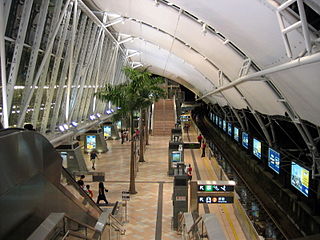
Sunny Bay is an MTR station in Yam O. It is between Tung Chung and Tsing Yi stations. The station is an interchange station between the Tung Chung line and the Disneyland Resort line to Hong Kong Disneyland. The station was originally to be named Yam O ; however, the name was ultimately replaced, likely because of its ominous connotations.

East Tsim Sha Tsui is a station of the Mass Transit Railway (MTR) system of Hong Kong. It is currently an intermediate station on the Tuen Ma line.

Tsing Yi is an interchange station of the MTR between the Tung Chung line and Airport Express on Tsing Yi Island in Hong Kong. The station is located between Sunny Bay station and Lai King station on the Tung Chung Line, and between Airport station and Kowloon station on the Airport Express. The livery of the station is dull teal. Tsing Yi station is connected to a major interchange for buses and maxicabs, situated adjacent to the station, which serves as a public transport hub for the New Territories. It is embedded into the Maritime Square shopping centre.

Admiralty is a station of the MTR rapid transit system in Admiralty, Hong Kong.
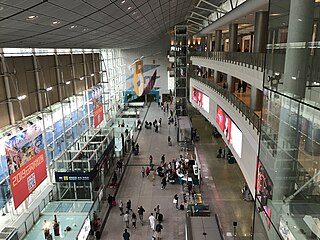
Hong Kong is a station of the MTR metro system in Hong Kong. It is the eastern terminus of the Tung Chung line and Airport Express. It is situated between Man Cheung Street and Harbour View Street, Central, Hong Kong Island, and sits underneath the International Finance Centre (IFC). It opened on 22 June 1998.
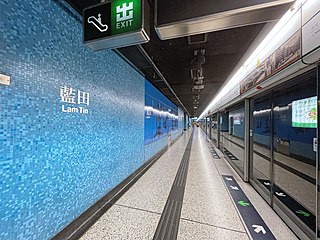
Lam Tin is a station on the Hong Kong MTR Kwun Tong line built as a part of the extension to Quarry Bay. The station is linked to the nearby hillside community of Lam Tin by a series of escalators.

Tung Chung is a station on the Tung Chung line of the MTR rapid transport system in Hong Kong. As the western end of the Tung Chung line, it is also a transfer point of those wishing to use the Ngong Ping Cable Car and by bus to the rest of Lantau Island. As with all other MTR stations, Tung Chung has a unique colour scheme used throughout the station, in this case lavender.
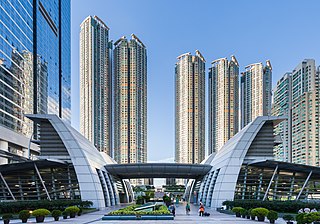
Kowloon is a station on the Tung Chung line and the Airport Express of Hong Kong's MTR. It is one of the two Airport Express stations providing in-town check-in services for passengers departing from Hong Kong International Airport and free shuttle bus services to most major hotels in the Tsim Sha Tsui and Yau Ma Tei areas.

Lo Wu is the northern terminus of the East Rail line of Hong Kong, located in Lo Wu within the Closed Area on Hong Kong's northern frontier. The station serves as a primary checkpoint for rail passengers between Hong Kong and mainland China and vice versa, rather than serving a specific area. It is also the northernmost railway station in Hong Kong.

Hung Hom is a passenger railway station in Hung Hom, Kowloon, Hong Kong. It is an interchange station between the East Rail line and the Tuen Ma line domestic services of the MTR network, as well as the southern terminus of cross-border through-trains to mainland China which has been suspended since 4 February 2020. The station is one of four Hong Kong ports of entry on the MTR network; the others are Lo Wu, Lok Ma Chau, and West Kowloon. This station serves the southern terminus of the East Rail Line in early morning before the first northbound train from Admiralty arrives. As the station is located next to the Cross-Harbour Tunnel's northern portal, it is also served by many cross-harbour bus routes.

The Aviation history of Hong Kong began in Sha Tin on 18 March 1911, when Belgian pilot Charles den Born successfully took off on an aeroplane retrospectively named Spirit of Sha Tin. A replica of the aircraft is hung at the new Chep Lap Kok airport above the arrivals hall.

AsiaWorld–Expo is the western terminus of the Airport Express of the Hong Kong MTR. It serves the AsiaWorld–Expo in the northeast corner of Chek Lap Kok, the island on which the Hong Kong International Airport is located.

The Hong Kong International Airport APM is a driverless people mover located within Hong Kong International Airport. It operates in two segments within Terminal 1 and the Midfield Concourse, and between Terminals 1, and also connects to the Skypier. It used to also serv Terminal 2 prior to 2019 but due to redevelopment works, Terminal 2 is not in service and services between Skypier and Terminal 1 pass through Terminal 2 without stopping.

Hong Kong SkyCity is a large business and entertainment complex adjacent to Hong Kong International Airport, and is built on land owned by the Airport Authority Hong Kong. It currently includes the AsiaWorld–Expo, Terminal 2 (SkyPlaza) and SkyPier.
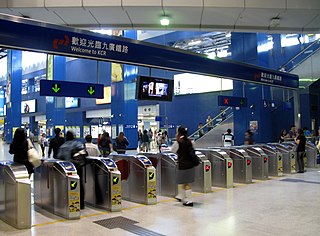
In rail transport, the paid area is a dedicated "inner" zone in a railway station or metro station, accessible via turnstiles or other barriers, to get into which, visitors or passengers require a valid ticket, checked smartcard or a pass. A system using paid areas is often called fare control. Passengers are allowed to enter or exit only through a faregate. A paid area usually exists in rapid transit railway stations for separating the train platform from the station exit, ensuring a passenger has paid or prepaid before reaching the railway platform and using any transport service. Such design requires a well-organized railway station layout. In some systems, paid areas are named differently - for example, on railways in the United Kingdom they are called compulsory ticket areas.
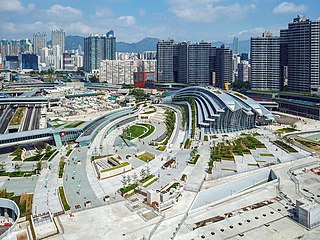
West Kowloon station, also known as Hong Kong West Kowloon, is the southern terminus of and the only station on the Hong Kong section of the Guangshengang XRL. The station connects to China's high-speed rail (HSR) network across the border through dedicated tunnels and includes a Mainland Port Area where the laws of (Mainland) China are enforced. It was constructed by the MTR Corporation Limited as the project manager commissioned by the Hong Kong Government, through subcontractors.
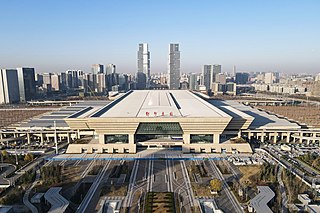
The Zhengzhoudong railway station is a railway station for high-speed trains in Zhengzhou, Henan, China. It is located approximately 3 km southeast of the Zhengdong New Area CBD. On the junction of the North-South Beijing–Guangzhou–Shenzhen–Hong Kong high-speed railway and the East-West Xuzhou–Lanzhou high-speed railway, it is one of the largest passenger railway stations in China.






















